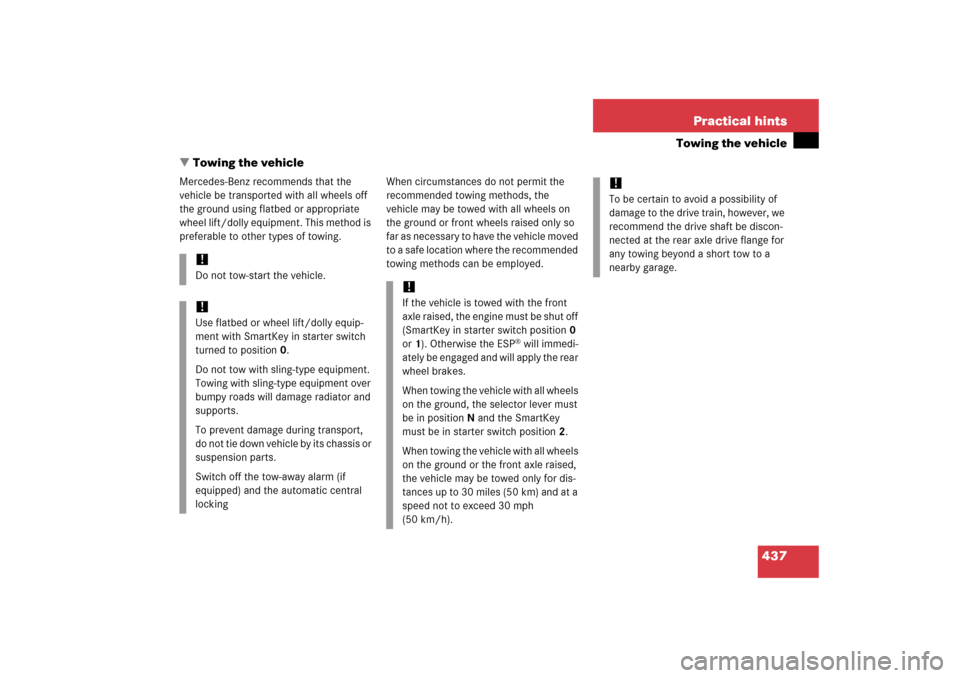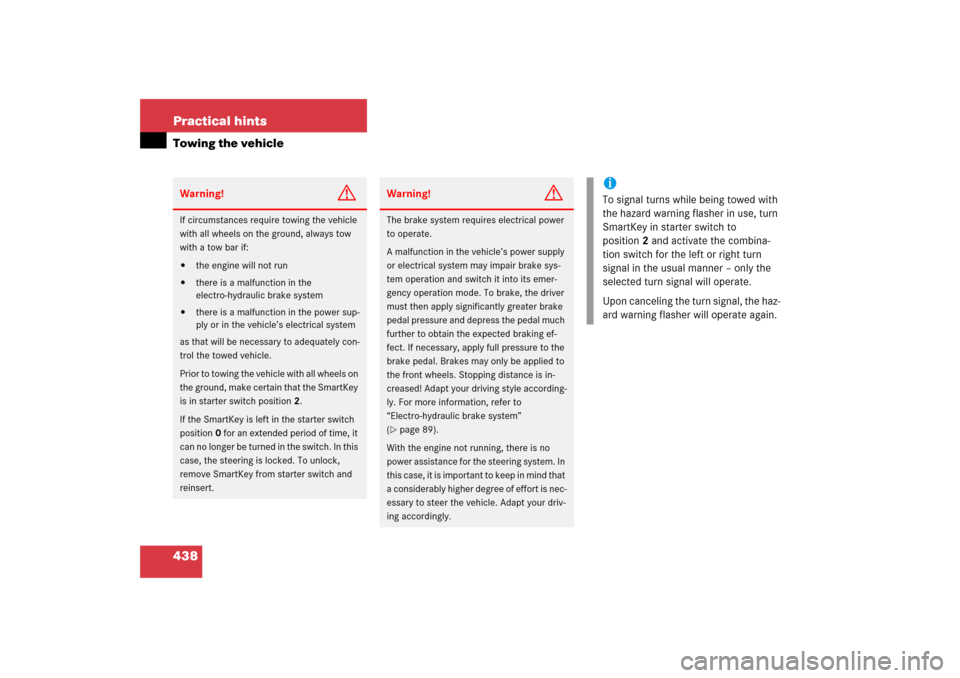Page 437 of 498

436 Practical hintsJump starting�
Always make sure the jumper cables
are not on or near pulleys, fans or other
parts that move when the engine is
started or running.
The main battery is located in the trunk un-
derneath the luggage box (
�page 401).
�
Make sure the two vehicles do not
touch.
�
Turn off all electrical consumers.
�
Apply parking brake.
�
Shift gear selector lever to positionP.
�
Connect positive terminals1 and3
of the batteries with the jumper cable.
Clamp cable to charged battery3
first.
1Positive terminal of discharged battery
2Negative terminal of discharged bat-
tery
3Positive terminal of charged battery
4Negative terminal of charged battery
�
Start engine of the vehicle with the
charged battery and run at idle speed.
�
Connect negative terminals4 and2
of the batteries with the jumper cable.
Clamp cable to charged battery4
first.
�
Start the engine of the disabled vehi-
cle.
Now you can again turn on the electrical
consumers. Do not turn on the lights under
any circumstances.
�
Remove the jumper cables first from
negative terminals2 and4 and then
from positive terminals1 and3.
Now you can turn on the lights.
�
Have the battery checked at the near-
est authorized Mercedes-Benz Center.
Warning!
G
Keep flames or sparks away from battery.
Do not smoke.
Observe all safety instructions and precau-
tions when handling automotive batteries
(�page 299).
!Never invert the terminal connections!
iThe message
Malfunction - electric
consumers switched off
may appear
in the instrument cluster. It will disap-
pear as soon as the battery is suffi-
ciently charged.
Page 438 of 498

437 Practical hints
Towing the vehicle
�Towing the vehicle
Mercedes-Benz recommends that the
vehicle be transported with all wheels off
the ground using flatbed or appropriate
wheel lift/dolly equipment. This method is
preferable to other types of towing.When circumstances do not permit the
recommended towing methods, the
vehicle may be towed with all wheels on
the ground or front wheels raised only so
far as necessary to have the vehicle moved
to a safe location where the recommended
towing methods can be employed.
!Do not tow-start the vehicle.!Use flatbed or wheel lift/dolly equip-
ment with SmartKey in starter switch
turned to position0.
Do not tow with sling-type equipment.
Towing with sling-type equipment over
bumpy roads will damage radiator and
supports.
To prevent damage during transport,
do not tie down vehicle by its chassis or
suspension parts.
Switch off the tow-away alarm (if
equipped) and the automatic central
locking
!If the vehicle is towed with the front
axle raised, the engine must be shut off
(SmartKey in starter switch position0
or1). Otherwise the ESP
® will immedi-
ately be engaged and will apply the rear
wheel brakes.
When towing the vehicle with all wheels
on the ground, the selector lever must
be in positionN and the SmartKey
must be in starter switch position2.
When towing the vehicle with all wheels
on the ground or the front axle raised,
the vehicle may be towed only for dis-
tances up to 30 miles (50 km) and at a
speed not to exceed 30 mph
(50 km/h).
!To be certain to avoid a possibility of
damage to the drive train, however, we
recommend the drive shaft be discon-
nected at the rear axle drive flange for
any towing beyond a short tow to a
nearby garage.
Page 439 of 498

438 Practical hintsTowing the vehicleWarning!
G
If circumstances require towing the vehicle
with all wheels on the ground, always tow
with a tow bar if:�
the engine will not run
�
there is a malfunction in the
electro-hydraulic brake system
�
there is a malfunction in the power sup-
ply or in the vehicle’s electrical system
as that will be necessary to adequately con-
trol the towed vehicle.
Prior to towing the vehicle with all wheels on
the ground, make certain that the SmartKey
is in starter switch position2.
If the SmartKey is left in the starter switch
position0 for an extended period of time, it
can no longer be turned in the switch. In this
case, the steering is locked. To unlock,
remove SmartKey from starter switch and
reinsert.
Warning!
G
The brake system requires electrical power
to operate.
A malfunction in the vehicle’s power supply
or electrical system may impair brake sys-
tem operation and switch it into its emer-
gency operation mode. To brake, the driver
must then apply significantly greater brake
pedal pressure and depress the pedal much
further to obtain the expected braking ef-
fect. If necessary, apply full pressure to the
brake pedal. Brakes may only be applied to
the front wheels. Stopping distance is in-
creased! Adapt your driving style according-
ly. For more information, refer to
“Electro-hydraulic brake system”
(�page 89).
With the engine not running, there is no
power assistance for the steering system. In
this case, it is important to keep in mind that
a considerably higher degree of effort is nec-
essary to steer the vehicle. Adapt your driv-
ing accordingly.
iTo signal turns while being towed with
the hazard warning flasher in use, turn
SmartKey in starter switch to
position2 and activate the combina-
tion switch for the left or right turn
signal in the usual manner – only the
selected turn signal will operate.
Upon canceling the turn signal, the haz-
ard warning flasher will operate again.
Page 444 of 498
443 Technical data
Parts service
Warranty coverage
Identification labels
Layout of poly-V-belt drive
Engine
Rims and tires
Electrical system
Main dimensions
Weights
Fuels, coolants, lubricants etc.
Page 447 of 498
446 Technical dataIdentification labels1Certification label (includes Paintwork
code)2Vehicle Identification Number (VIN)
3Emission control information label, in-
cludes both federal and California cer-
tification exhaust emission standards
4Vacuum line routing diagram label
5Vehicle Identification Number (VIN)
(lower edge of windshield)
6Engine number (engraved on engine)
iWhen ordering parts, please specify ve-
hicle identification and engine num-
bers.
Page 449 of 498

448 Technical dataEngineModel
CLS 500 (219.375)
CLS 55 AMG (219.376
1)
1The quoted data apply only to the standard vehicle. See an authorized Mercedes-Benz Center for the corresponding data of all special bodies and special equipment.Engine
M113
M113
Mode of operation
4-stroke engine, gasoline injection
4-stroke engine, gasoline injection
No. of cylinders
8
8
Bore
3.82 in (97.00 mm)
3.82 in (97.00 mm)
Stroke
3.31 in (84.00 mm)
3.60 in (92.00 mm)
Total piston displacement
303.0 cu in (4 966 cm
3)
331.8 cu in (5 439 cm
3)
Compression ratio
10:1
9:1
Output acc. to SAE J 1349
302 hp/5 600 rpm
2
(225 kW/5 600 rpm)
469 hp/6 100 rpm
2
(350 kW/6 100 rpm)
2Premium fuel required. Performance may vary with fuel octane rating.Maximum torque acc. to SAE J 1349
339 lb-ft/2 700 rpm - 4 250 rpm
(460 Nm/2 700 rpm - 4 250 rpm)
516 lb-ft/2 650 rpm - 4 500 rpm
(700 Nm/2 650 rpm - 4 500 rpm)
Maximum engine speed
6300 rpm
6500 rpm
Firing order
1-5-4-2-6-3-7-8
1-5-4-2-6-3-7-8
Poly-V-belt
Belt one: 2 390 mm
Belt one: 1 289 mmBelt two: 2 449 mm
Page 462 of 498
461 Technical data
Fuels, coolants, lubricants etc.
�Fuels, coolants, lubricants etc.
CapacitiesVehicle components and their respective
lubricants must match. Therefore only use
products tested and approved by
Mercedes-Benz.Please refer to the Factory Approved Ser-
vice Products Pamphlet, or inquire at your
authorized Mercedes-Benz Center.
Model
Capacity
Fuels, coolants, lubricants etc.
Engine with oil filter
CLS 500
8.0 US qt (7.5 l)
Approved engine oils
CLS 55 AMG
9.0 US qt (8.5 l)
Automatic transmission
CLS 500
8.5 US qt (8.0 l)
MB Automatic Transmission Fluid
CLS 55 AMG
8.67 US qt (8.2 l)
Rear axle
1.37 US qt (1.3 l)
Hypoid gear oil SAE 85 W 90
Page 465 of 498

464 Technical dataFuels, coolants, lubricants etc.Engine oils
Engine oils are specifically tested for their
suitability in our engines and durability for
our service intervals. Therefore, only use
approved engine oils and oil filters re-
quired for vehicles with Maintenance Sys-
tem (U.S. vehicles) or FSS PLUS (Canada
vehicles). For a listing of approved engine
oils and oil filters, refer to the Factory Ap-
proved Service Products pamphlet, or con-
tact an authorized Mercedes-Benz Center.
Engine oil additives
Do not blend oil additives with engine oil.
They may damage the engine.
Damage or malfunctions resulting from
blending oil additives are not covered by
the Mercedes-Benz Limited Warranty.Air conditioning refrigerant
R-134a (HFC) refrigerant and special PAG
lubricating oil are used in the air condition-
ing system.
Never use R-12 (CFC) or mineral-based lu-
bricating oil. Otherwise damage to the
system will occur.
Brake fluid
During vehicle operation, the boiling point
of the brake fluid is continuously reduced
through the absorption of moisture from
the atmosphere.
Only brake fluid approved by
Mercedes-Benz is recommended. Your
authorized Mercedes-Benz Center will pro-
vide you with additional information.
!Using engine oils and oil filters of spec-
ification other than those expressly re-
quired for the Maintenance System
(U.S. vehicles) or FSS PLUS (Canada
vehicles), or changing of oil and oil filter
at change intervals longer than those
called for by the Maintenance System
(U.S. vehicles) or FSS PLUS (Canada
vehicles) will result in engine damage
not covered by the Mercedes-Benz
Limited Warranty.
Please follow Maintenance System
(U.S. vehicles) or FSS PLUS (Canada
vehicles) recommendations for sched-
uled oil changes. Failure to do so could
result in engine damage not covered by
the Mercedes-Benz Limited Warranty.
Warning!
G
Under extremely strenuous operating condi-
tions, this moisture content can lead to the
formation of bubbles in the system, thus re-
ducing the system’s efficiency.
Therefore, the brake fluid must be replaced
regularly. Refer to your vehicle’s Mainte-
nance Booklet for replacement interval.